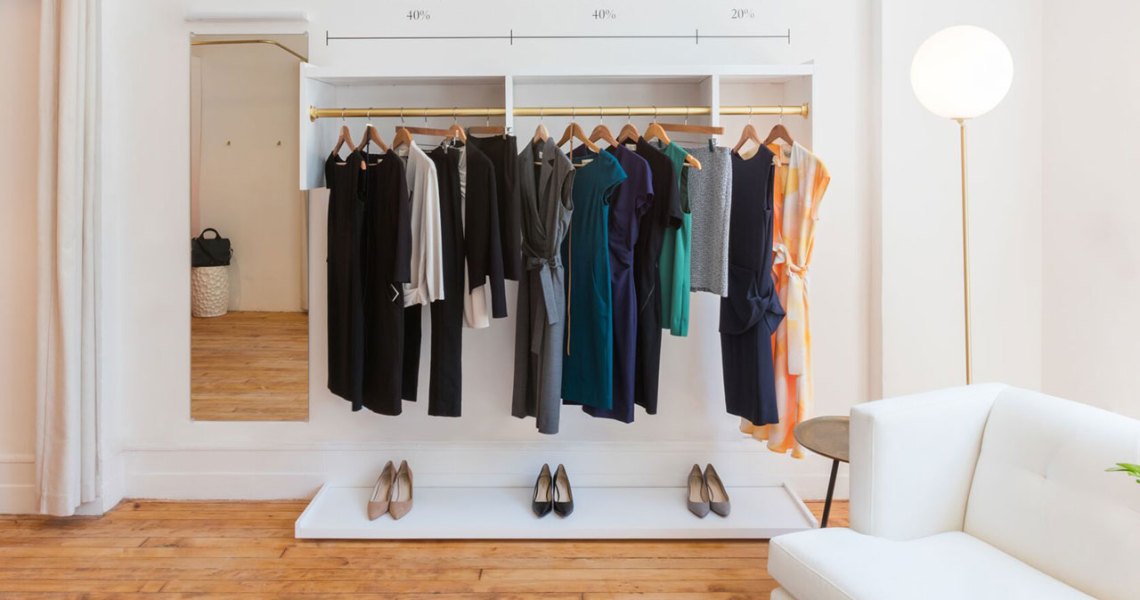MM.LaFleur’s showroom, located on the fourth floor of an old-fashioned building in the SoHo neighborhood of Manhattan, doesn’t feel like a store. A standing lamp and two cream-colored lounge chairs sit in front of two long windows, a bookshelf is adorned with books, photographs, plants and ornaments, and only a dozen corporate-looking dresses, skirts and jackets hang on a single rack on the opposite side of the room.
There’s no inventory in the space and the customers, predominantly business women looking for classic and simple corporate wear, don’t browse MM.LaFleur’s clothes. Instead, they book a one hour appointment to try 10 pieces that are selected by a stylist before hand.
Most of the clothing doesn’t get bought in the store though: A majority of MM. LaFleur’s customers order what’s called a “Bento Box,” where a stylist picks four to six items, as well as accessories, and sends them to a customer at home so they can try before they buy. It’s not a subscription service however, and there’s no pressure for customers to sign up for a regular box.

MM.LaFleur’s Bento Box, which woman can be sent to try before they buy.
The three-year-old company’s secret ingredient to knowing what their customers want is data, gathered in an online questionnaire as a first point of contact. The questions include what size the customer wears of other brands, their preference of style, color, and cut, how formal they want their wardrobe to be, and questions around their body shape. But the final question, “Is there anything else you’d like us to know,” is what offers the brand’s stylist perhaps the most valuable information.
“It’s almost shocking how personal they get,” said Sarah LaFleur, one of the brands founders. “It’s everything from, ‘I’ve just had a baby, I used to be this size and now I’m this size and I’m trying to get comfortable with it. Can you help me to build a new wardrobe?’ to ‘I just lost my job and and I’ve got interviews and I want a piece that makes me feel confident,” she said, adding it’s that kind of information that helps stylists pick items they think a woman would want.
Ad position: web_incontent_pos1
LaFleur founded the company in 2013 after working in finance herself, and named it MM.LeFleur after her mother’s nickname Mémé, which means “eyes” in Japanese. It was during her career in finance that she saw a gap in the market for an easy shopping experience and basic, classic pieces for women to wear in corporate jobs, at an affordable price point (the brand’s dresses retail for between $150 and $360). She partnered with former head designer for Zac Posen, Miyako Nakamura and former consulting colleague, Naire Foster, to address the gap.
The brand represents a shift that’s occurring in the retail industry. Where traditional retail models are centered around pushing products to customers and gathering data once they’ve shopped, new retailers like MM.LaFleur are beginning with customers and offering them a service and product in the hopes to build loyalty and drive sales that way, said Emily Collins, senior analyst at Forrester. “From a customer loyalty perspective this is one of the smartest moves.”
Knowing what a customer likes, and her preferences for color, fabric, and styles, can also help drive sales when a new piece is released. “If someone writes ‘I love this and wear it all the time,’ and we release it in a new color, chances are she’d want to know about it,” said LaFleur. The company also uses feedback to alter its pieces, from length to hemlines, fabric and cut. One of its best sellers, the Sarah 6.0, is in its sixth iteration.
Adjusting sizes to drive down return rates and keep customers coming back is something retailers across the board from Adidas to Kate Spade are trying to do, using technology like True Fit for example. Last year, there were $250 billion of lost sales as a result of returns across retail in the U.S., according to research firm Jane Hali and Associates. MM.LaFleur sees its approach to data as a win-win: They can improve styles with customer feedback, and create products they know are wanted and needed.
MM.LaFleur is on track to pull in $30 million in revenue this year, representing a growth of 450 percent year-over-year since it began in 2013. Its staff has also grown from three to 120 in the same time. It claims 40 percent of its customers come back within three months of their first purchase, which is high, according to the company.
Ad position: web_incontent_pos2
LaFleur said the main aim of the company is helping women who don’t want to, or don’t have the time to shop, buy clothes efficiently.
“We tell our customers, ‘We only want to see you four hours out of the year,” said LaFleur. “It’s not really meant to be a discovery experience, it’s more like we’ve got a job to do, that is to dress you, let’s get you in and get you out.”
Images courtesy of MM.LaFleur.




